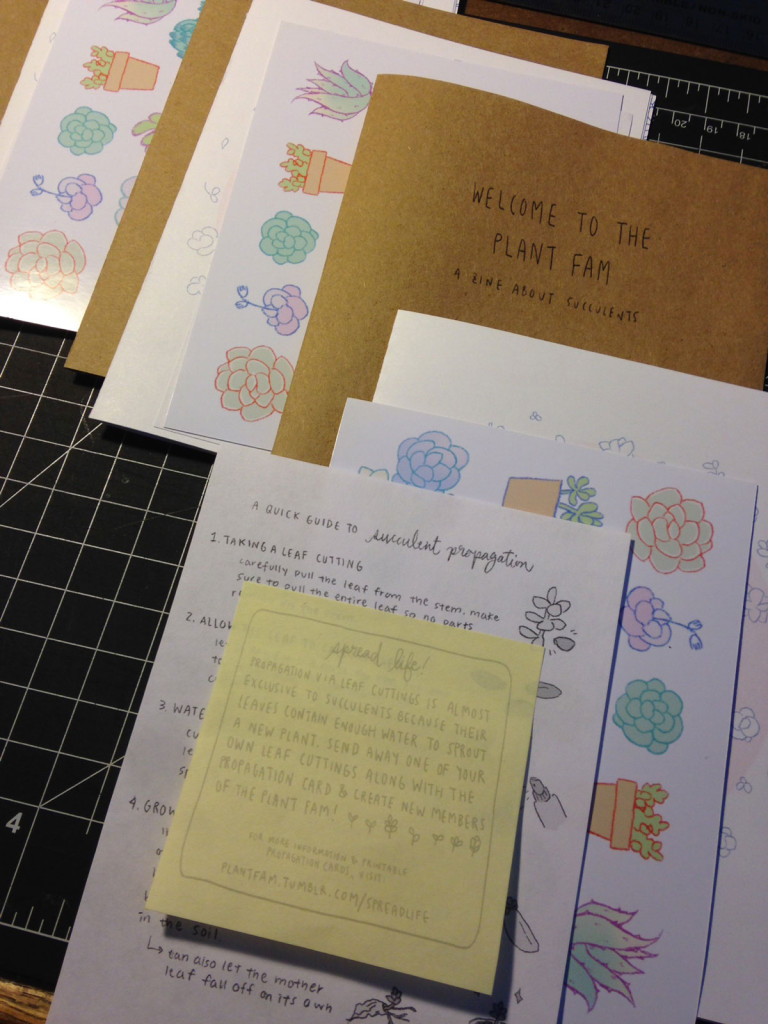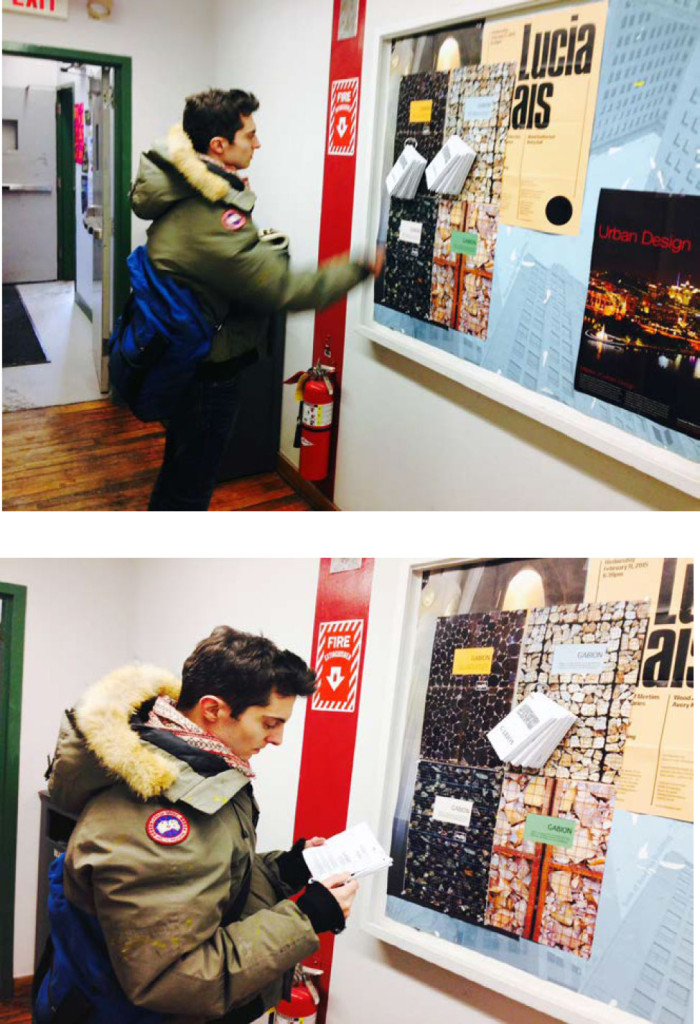
Modes of Self-Publishing Course, Instructor
June 12, 2015
Modes of Self-Publishing (MofSP), RISD course, 2015
A collaboration with Minkyoung Kim.
Modes of Self-Publishing focused on self-publishing, not just as a circulation platform for printed matter, but as an experimental vehicle for visual or verbal content. We looked at the history, making, and subculture notion of ‘zine’ making, then attempted to push the boundaries of what that could be. Students explored the various potentials of self-publishing: systems of assembly, collaboration, collective authorship, multiplicity of topic and form, and distribution concepts that pushed strategies of encounter. This included students of graphic design and other disciplines such as illustration, printmaking, and landscape architecture. I wanted to consider a pedagogical way in which to share areas of research with others in creative exchange. The experience of co-teaching dynamically integrated my thesis investigation with that of Minkyoung Kim’s into projects and critique, class interactions, and how rules can foster a space to experiment. Our focus as a group was on process.
course syllabus:
Overview
Zines are typically self-published works with small circulations. Because of their spontaneity and low-fi craft, they allow individuals to express a broad range of voices in a rapidly shareable way; a device that has endured via sub-cultures that do not rely on power structures to function. Now, in a media landscape made more accessible through new technology, the definition of zines needs to be reassessed. What kind of forms and distribution strategies are possible via various modes such as printed matter, web, and mobile apps? What role does independent publishing play in a time when ideas are readily shared across moderated online platforms?
We will explore ‘zine’, not just as a circulation platform for printed matter, but as an experimental vehicle for visual or verbal content. Through discussion and research, we will consider historical context and study a range of makers who use independent publishing as a medium. Bringing this into our own practice, we will learn how to visually express ideas that are openly distributed and can expand independent publication strategies in the context of contemporary media. You will create, curate, and circulate work whose meaning is amplified by its own process.
Course Goals
– Assembly: exploring different systems to compose content
– Collectivity: working with others to allow collective authorship
– Multiplicity: investigating multiple media and taking that as an opportunity to experiment with formal outcomes
– Distribution: building distributional strategies as an extension of concept
Structure
Class will be a mixture of projects, group critiques, and reading discussions. In each project, students will explore different modes of production based on our course goals. Readings will be distributed weekly. We will discuss the readings in class every monday, in relation to design, practice, and theory. Everyone will prepare two questions in response to each reading and post them on our class website prior to that discussion. Brief overviews about tools for print / digital publication will be provided when it is necessary.
student work:
The Final Project focused on distribution, user encounter and user engagement:
Helen Gao, Illustration:
Shoada Hu, Landscape Architecture:
Project 3 focused on multi-form iteration and collaboration:
Rachel Tandon, Elise Mortenson, Fran Brauning:

Max Coleman, AlexanderKalomeris, Wayne Llang
project 2 focused on rapid making as an exquisite corpse process, with us teachers finishing the book cover and giving to students:
Our conversation as article for RISD Graduate Studies journal, We Begin When We Finish We Begin, published 2015:
Teaching Modes of Self-Publishing
Minkyoung Kim and Christina Webb (MFA Graphic Design 2015)
This Wintersession we co-taught a course on independent publication strategies in the context of contemporary media. We took the zine as a model for cooperative assembly, collective authorship, and distribution strategies, and applied these practices to various modes—from printed matter to the Web, video, sound, event, and installation. The course was open to students from all departments, and the four project assignments fostered interdisciplinary exchange and spontaneity.
In Project 1, “Object,” students chose an object, researched its personal, physical, historical, and cultural context, then articulated it using five different formal methods combined in a printed format. Shoada Huo, a graduate student in Landscape Architecture, chose the computer keyboard as his object. He researched design communication across cultures and represented multilingual keyboard variations using photocopies, photography, illustration, image transfer, and writing. The zine is structured as a double flipbook, so that the reader can recombine glyphs from two keyboards into one.
Project 2, “Circle,” investigated multiplicity of voice by relay, making literal the truth that each idea is influenced by those of others. Responding to a given keyword, “circle,” one student initiated a design. The next student selected an attribute of that design as the primary source for their new design. And so on. Each new design included a thumbnail of the preceding design, evidencing the chain’s history when all pieces came together as a set. With the process complete, we integrated the parts into a whole publication.
For Project 3, “Modes,” small teams produced a zine on a complex conceptual idea and delivered it in at least two media formats to explore how the mode of delivery can extend a concept. The project also revealed how working in a group fosters shared authorship. One team working on the theme of personal identity sought to give everyone “a platform to express their identity without restrictions or categories,” according to team member Elise Mortenson, a Brown-RISD Dual Degree Program student. They held a party before publishing their zine so that audience participation would generate its content. The physical zine is a box containing six clay objects made by participants along with a booklet that includes the team’s reflective writing, event documentation, and a catalogue of the clay objects. Online elements included a Facebook invite with comment thread and a tumblr archive of the photographed objects.
Project 4, we asked everyone to consider their previous projects and select some part to push further. This time, they were to design and build distribution strategies concurrently and document the entire process, including their readers’ engagement. Foundation student Helen Gao made a zine called Welcome to the Plant Fam about succulents, whose clippings are often shared and replanted in a botanical form of distribution. The zine contains instructions, creative writing, an interactive illustration with stickers, and plantable seed paper. At her launch party, the zine and plants were exchanged as gestures of distribution.
We each brought influences into the project goals and critique. For example, I (Minkyoung) focused on building a various type of structure for students to illuminate the connection between individual contents. This is related with my thesis question: how a designer can frame multiple contents in terms of influence. One of my projects, A Tree of Brushes is a recursive drawing program that allows users to save their drawings as brush strokes for future users. In this way, individual iterations influence the next iterations, creating a flow of results. Through these chain reactions, Individual drawings are understood within a larger chain of events, rather than what a depicted individual figure stands for.
My (Christina) work uses social spaces as sites of investigation, then experiments with various methods to look at how we are engaging with sites, and the cultural context within them. I brought this into our course in how we pushed criticality, concepts across media, and user encounter. One example of this is a web-to-print weekly news reader that I developed this past fall. 4th Wave is a capture of the topic of feminism as it has been trending in online news, and is designed to question how we are reading information online. The content organizing system and placement is automated by a script and CSS styles: the vertically “scrolling” front side is images at their downloaded size, related links and article titles. The related links are scaled up to flip the standard hierarchy of the webpage. The reframing gives form to the perpetualism and multi-dimensionality of feminism. What patterns or complexities are revealed through chance arrangements over time. The missing article text populates the back side in a more typical book format. When it is printed as a continuous sheet of paper it is perforated so it can tear apart to become distributable flyers. This is distributed as online content or can be printed as loose sheets by anyone with a printer.
Modes of Self-Publishing gave us together with the students an opportunity to explore what self-publishing can look like today. As teachers, we learned to design a strong curriculum and to be flexible and responsive to the unanticipated momentum of the group. As graphic designers, we learned how our own interests in systems and rules, public engagement, and conceptual and critical methods play out in a larger, pedagogical context. Co-teaching this course offered us another kind of cooperative assembly, collective authorship, and distribution that will continue to inspire and inform our future work.
© 2025 Christina Webb










